Analyzing Juvenile Gang Violence: Risk Factors and Prevention
VerifiedAdded on 2023/05/31
|11
|2557
|402
Essay
AI Summary
This essay delves into the multifaceted issue of juvenile gang violence in the USA, examining its prevalence, evolving nature, and the increasing use of firearms. It explores the critical need for a standardized definition of gangs and highlights the interconnectedness of gangs, drugs, guns, and violence. The essay identifies various risk factors contributing to gang involvement, categorized into individual, school, family, community, and peer group influences. It emphasizes the role of family dynamics, school performance, peer relationships, and societal conditions in shaping a young person's susceptibility to gang membership. Furthermore, the essay discusses the motivations behind joining gangs, including a search for belonging, protection, and involvement in criminal activities. It concludes by advocating for a balanced approach involving prevention, intervention, and suppression strategies, including training for parents and educators, school policy reviews, and increased adult supervision to combat the issue of juvenile gang violence. The essay underscores the importance of community-based evaluations to develop targeted action plans to address the issue of gang violence.

ESSAY
2018
STUDENT DETAILS:
[CRIMINAL JUSTICE]
2018
STUDENT DETAILS:
[CRIMINAL JUSTICE]
Secure Best Marks with AI Grader
Need help grading? Try our AI Grader for instant feedback on your assignments.
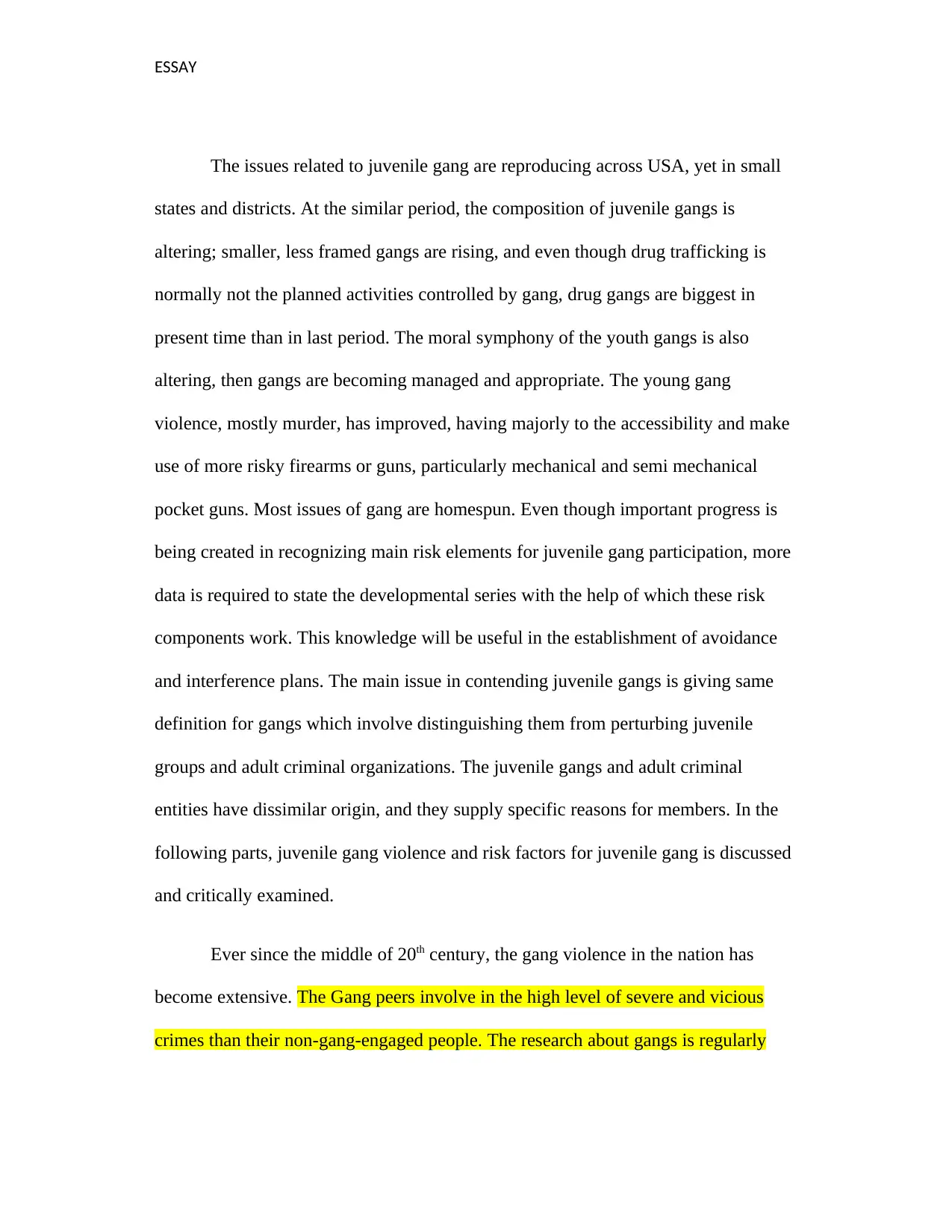
ESSAY
The issues related to juvenile gang are reproducing across USA, yet in small
states and districts. At the similar period, the composition of juvenile gangs is
altering; smaller, less framed gangs are rising, and even though drug trafficking is
normally not the planned activities controlled by gang, drug gangs are biggest in
present time than in last period. The moral symphony of the youth gangs is also
altering, then gangs are becoming managed and appropriate. The young gang
violence, mostly murder, has improved, having majorly to the accessibility and make
use of more risky firearms or guns, particularly mechanical and semi mechanical
pocket guns. Most issues of gang are homespun. Even though important progress is
being created in recognizing main risk elements for juvenile gang participation, more
data is required to state the developmental series with the help of which these risk
components work. This knowledge will be useful in the establishment of avoidance
and interference plans. The main issue in contending juvenile gangs is giving same
definition for gangs which involve distinguishing them from perturbing juvenile
groups and adult criminal organizations. The juvenile gangs and adult criminal
entities have dissimilar origin, and they supply specific reasons for members. In the
following parts, juvenile gang violence and risk factors for juvenile gang is discussed
and critically examined.
Ever since the middle of 20th century, the gang violence in the nation has
become extensive. The Gang peers involve in the high level of severe and vicious
crimes than their non-gang-engaged people. The research about gangs is regularly
The issues related to juvenile gang are reproducing across USA, yet in small
states and districts. At the similar period, the composition of juvenile gangs is
altering; smaller, less framed gangs are rising, and even though drug trafficking is
normally not the planned activities controlled by gang, drug gangs are biggest in
present time than in last period. The moral symphony of the youth gangs is also
altering, then gangs are becoming managed and appropriate. The young gang
violence, mostly murder, has improved, having majorly to the accessibility and make
use of more risky firearms or guns, particularly mechanical and semi mechanical
pocket guns. Most issues of gang are homespun. Even though important progress is
being created in recognizing main risk elements for juvenile gang participation, more
data is required to state the developmental series with the help of which these risk
components work. This knowledge will be useful in the establishment of avoidance
and interference plans. The main issue in contending juvenile gangs is giving same
definition for gangs which involve distinguishing them from perturbing juvenile
groups and adult criminal organizations. The juvenile gangs and adult criminal
entities have dissimilar origin, and they supply specific reasons for members. In the
following parts, juvenile gang violence and risk factors for juvenile gang is discussed
and critically examined.
Ever since the middle of 20th century, the gang violence in the nation has
become extensive. The Gang peers involve in the high level of severe and vicious
crimes than their non-gang-engaged people. The research about gangs is regularly
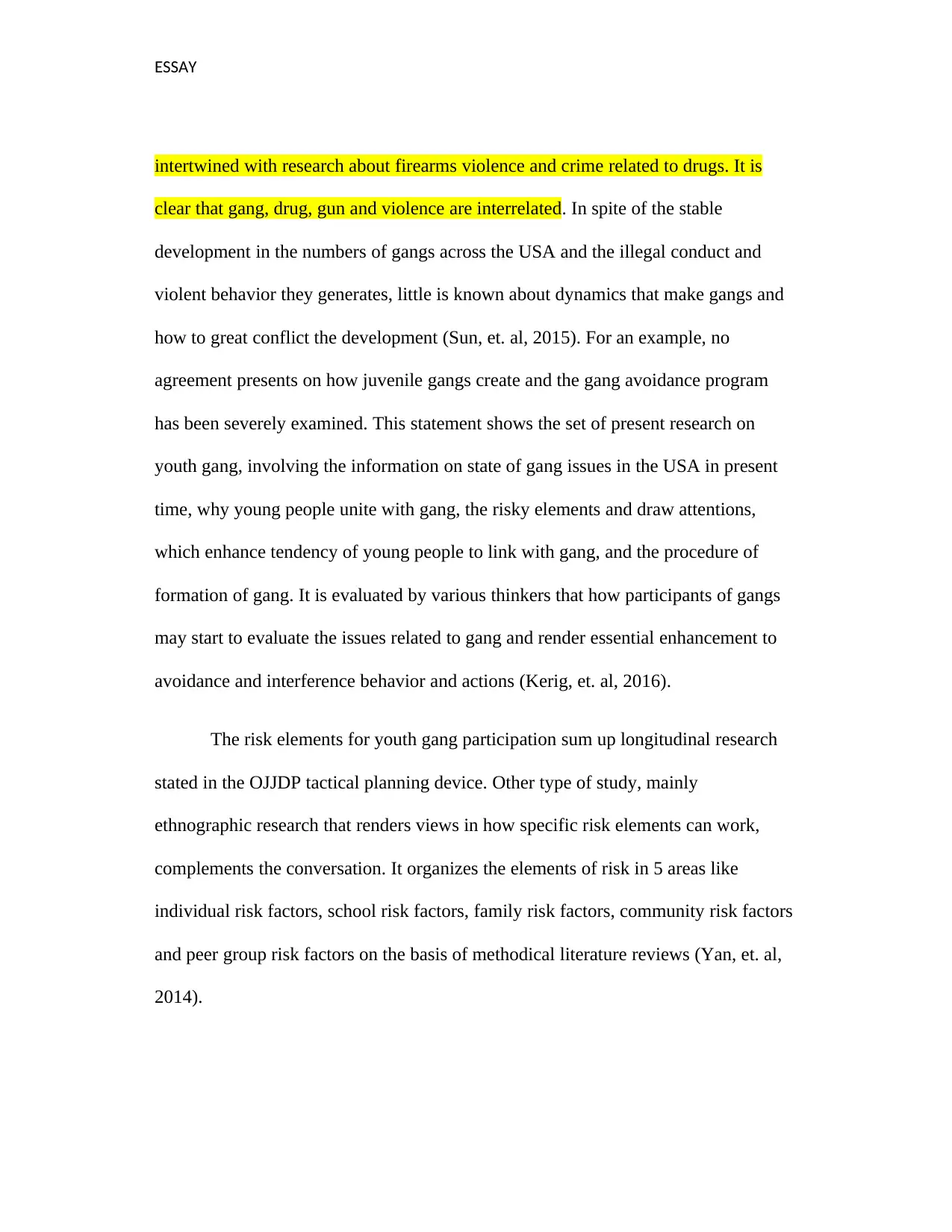
ESSAY
intertwined with research about firearms violence and crime related to drugs. It is
clear that gang, drug, gun and violence are interrelated. In spite of the stable
development in the numbers of gangs across the USA and the illegal conduct and
violent behavior they generates, little is known about dynamics that make gangs and
how to great conflict the development (Sun, et. al, 2015). For an example, no
agreement presents on how juvenile gangs create and the gang avoidance program
has been severely examined. This statement shows the set of present research on
youth gang, involving the information on state of gang issues in the USA in present
time, why young people unite with gang, the risky elements and draw attentions,
which enhance tendency of young people to link with gang, and the procedure of
formation of gang. It is evaluated by various thinkers that how participants of gangs
may start to evaluate the issues related to gang and render essential enhancement to
avoidance and interference behavior and actions (Kerig, et. al, 2016).
The risk elements for youth gang participation sum up longitudinal research
stated in the OJJDP tactical planning device. Other type of study, mainly
ethnographic research that renders views in how specific risk elements can work,
complements the conversation. It organizes the elements of risk in 5 areas like
individual risk factors, school risk factors, family risk factors, community risk factors
and peer group risk factors on the basis of methodical literature reviews (Yan, et. al,
2014).
intertwined with research about firearms violence and crime related to drugs. It is
clear that gang, drug, gun and violence are interrelated. In spite of the stable
development in the numbers of gangs across the USA and the illegal conduct and
violent behavior they generates, little is known about dynamics that make gangs and
how to great conflict the development (Sun, et. al, 2015). For an example, no
agreement presents on how juvenile gangs create and the gang avoidance program
has been severely examined. This statement shows the set of present research on
youth gang, involving the information on state of gang issues in the USA in present
time, why young people unite with gang, the risky elements and draw attentions,
which enhance tendency of young people to link with gang, and the procedure of
formation of gang. It is evaluated by various thinkers that how participants of gangs
may start to evaluate the issues related to gang and render essential enhancement to
avoidance and interference behavior and actions (Kerig, et. al, 2016).
The risk elements for youth gang participation sum up longitudinal research
stated in the OJJDP tactical planning device. Other type of study, mainly
ethnographic research that renders views in how specific risk elements can work,
complements the conversation. It organizes the elements of risk in 5 areas like
individual risk factors, school risk factors, family risk factors, community risk factors
and peer group risk factors on the basis of methodical literature reviews (Yan, et. al,
2014).
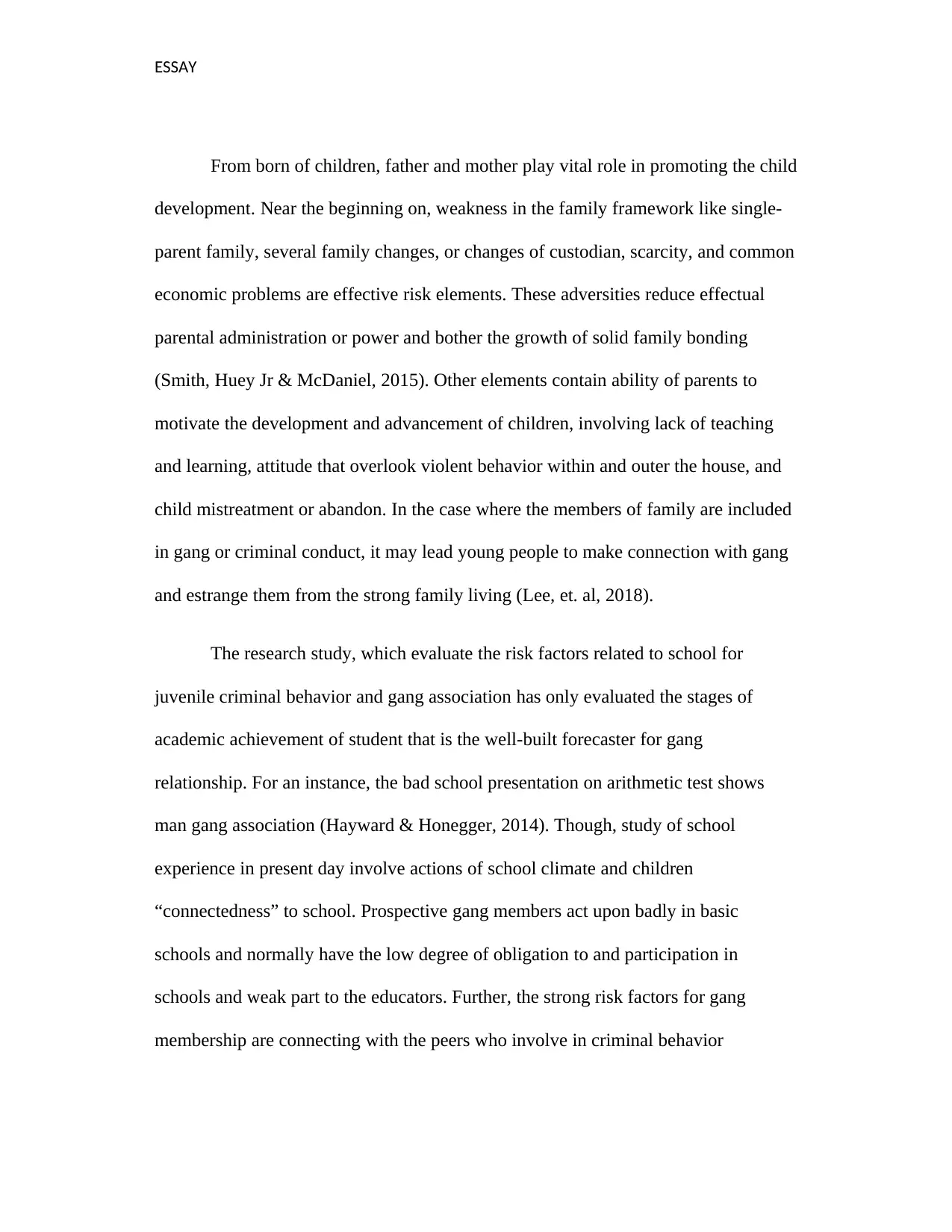
ESSAY
From born of children, father and mother play vital role in promoting the child
development. Near the beginning on, weakness in the family framework like single-
parent family, several family changes, or changes of custodian, scarcity, and common
economic problems are effective risk elements. These adversities reduce effectual
parental administration or power and bother the growth of solid family bonding
(Smith, Huey Jr & McDaniel, 2015). Other elements contain ability of parents to
motivate the development and advancement of children, involving lack of teaching
and learning, attitude that overlook violent behavior within and outer the house, and
child mistreatment or abandon. In the case where the members of family are included
in gang or criminal conduct, it may lead young people to make connection with gang
and estrange them from the strong family living (Lee, et. al, 2018).
The research study, which evaluate the risk factors related to school for
juvenile criminal behavior and gang association has only evaluated the stages of
academic achievement of student that is the well-built forecaster for gang
relationship. For an instance, the bad school presentation on arithmetic test shows
man gang association (Hayward & Honegger, 2014). Though, study of school
experience in present day involve actions of school climate and children
“connectedness” to school. Prospective gang members act upon badly in basic
schools and normally have the low degree of obligation to and participation in
schools and weak part to the educators. Further, the strong risk factors for gang
membership are connecting with the peers who involve in criminal behavior
From born of children, father and mother play vital role in promoting the child
development. Near the beginning on, weakness in the family framework like single-
parent family, several family changes, or changes of custodian, scarcity, and common
economic problems are effective risk elements. These adversities reduce effectual
parental administration or power and bother the growth of solid family bonding
(Smith, Huey Jr & McDaniel, 2015). Other elements contain ability of parents to
motivate the development and advancement of children, involving lack of teaching
and learning, attitude that overlook violent behavior within and outer the house, and
child mistreatment or abandon. In the case where the members of family are included
in gang or criminal conduct, it may lead young people to make connection with gang
and estrange them from the strong family living (Lee, et. al, 2018).
The research study, which evaluate the risk factors related to school for
juvenile criminal behavior and gang association has only evaluated the stages of
academic achievement of student that is the well-built forecaster for gang
relationship. For an instance, the bad school presentation on arithmetic test shows
man gang association (Hayward & Honegger, 2014). Though, study of school
experience in present day involve actions of school climate and children
“connectedness” to school. Prospective gang members act upon badly in basic
schools and normally have the low degree of obligation to and participation in
schools and weak part to the educators. Further, the strong risk factors for gang
membership are connecting with the peers who involve in criminal behavior
Secure Best Marks with AI Grader
Need help grading? Try our AI Grader for instant feedback on your assignments.
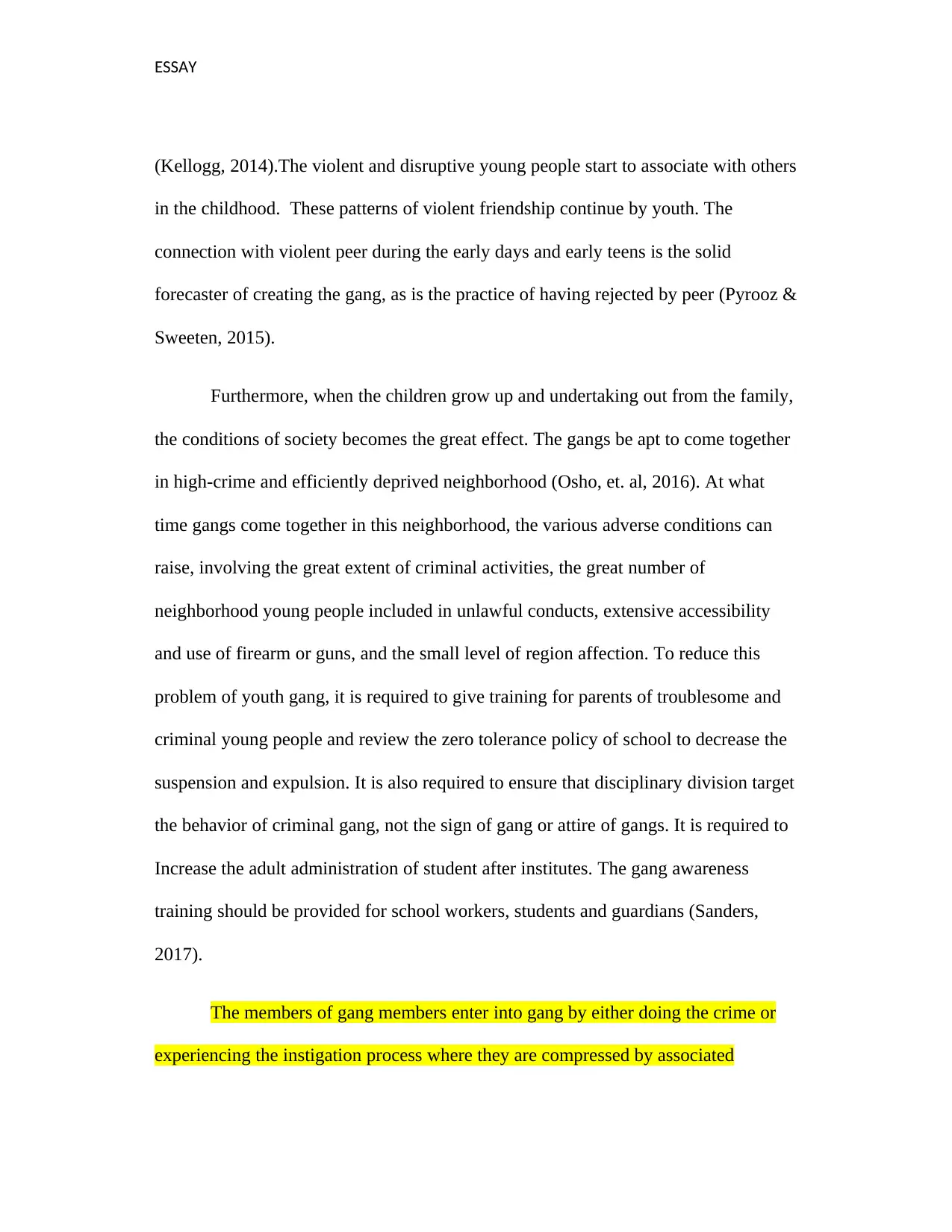
ESSAY
(Kellogg, 2014).The violent and disruptive young people start to associate with others
in the childhood. These patterns of violent friendship continue by youth. The
connection with violent peer during the early days and early teens is the solid
forecaster of creating the gang, as is the practice of having rejected by peer (Pyrooz &
Sweeten, 2015).
Furthermore, when the children grow up and undertaking out from the family,
the conditions of society becomes the great effect. The gangs be apt to come together
in high-crime and efficiently deprived neighborhood (Osho, et. al, 2016). At what
time gangs come together in this neighborhood, the various adverse conditions can
raise, involving the great extent of criminal activities, the great number of
neighborhood young people included in unlawful conducts, extensive accessibility
and use of firearm or guns, and the small level of region affection. To reduce this
problem of youth gang, it is required to give training for parents of troublesome and
criminal young people and review the zero tolerance policy of school to decrease the
suspension and expulsion. It is also required to ensure that disciplinary division target
the behavior of criminal gang, not the sign of gang or attire of gangs. It is required to
Increase the adult administration of student after institutes. The gang awareness
training should be provided for school workers, students and guardians (Sanders,
2017).
The members of gang members enter into gang by either doing the crime or
experiencing the instigation process where they are compressed by associated
(Kellogg, 2014).The violent and disruptive young people start to associate with others
in the childhood. These patterns of violent friendship continue by youth. The
connection with violent peer during the early days and early teens is the solid
forecaster of creating the gang, as is the practice of having rejected by peer (Pyrooz &
Sweeten, 2015).
Furthermore, when the children grow up and undertaking out from the family,
the conditions of society becomes the great effect. The gangs be apt to come together
in high-crime and efficiently deprived neighborhood (Osho, et. al, 2016). At what
time gangs come together in this neighborhood, the various adverse conditions can
raise, involving the great extent of criminal activities, the great number of
neighborhood young people included in unlawful conducts, extensive accessibility
and use of firearm or guns, and the small level of region affection. To reduce this
problem of youth gang, it is required to give training for parents of troublesome and
criminal young people and review the zero tolerance policy of school to decrease the
suspension and expulsion. It is also required to ensure that disciplinary division target
the behavior of criminal gang, not the sign of gang or attire of gangs. It is required to
Increase the adult administration of student after institutes. The gang awareness
training should be provided for school workers, students and guardians (Sanders,
2017).
The members of gang members enter into gang by either doing the crime or
experiencing the instigation process where they are compressed by associated
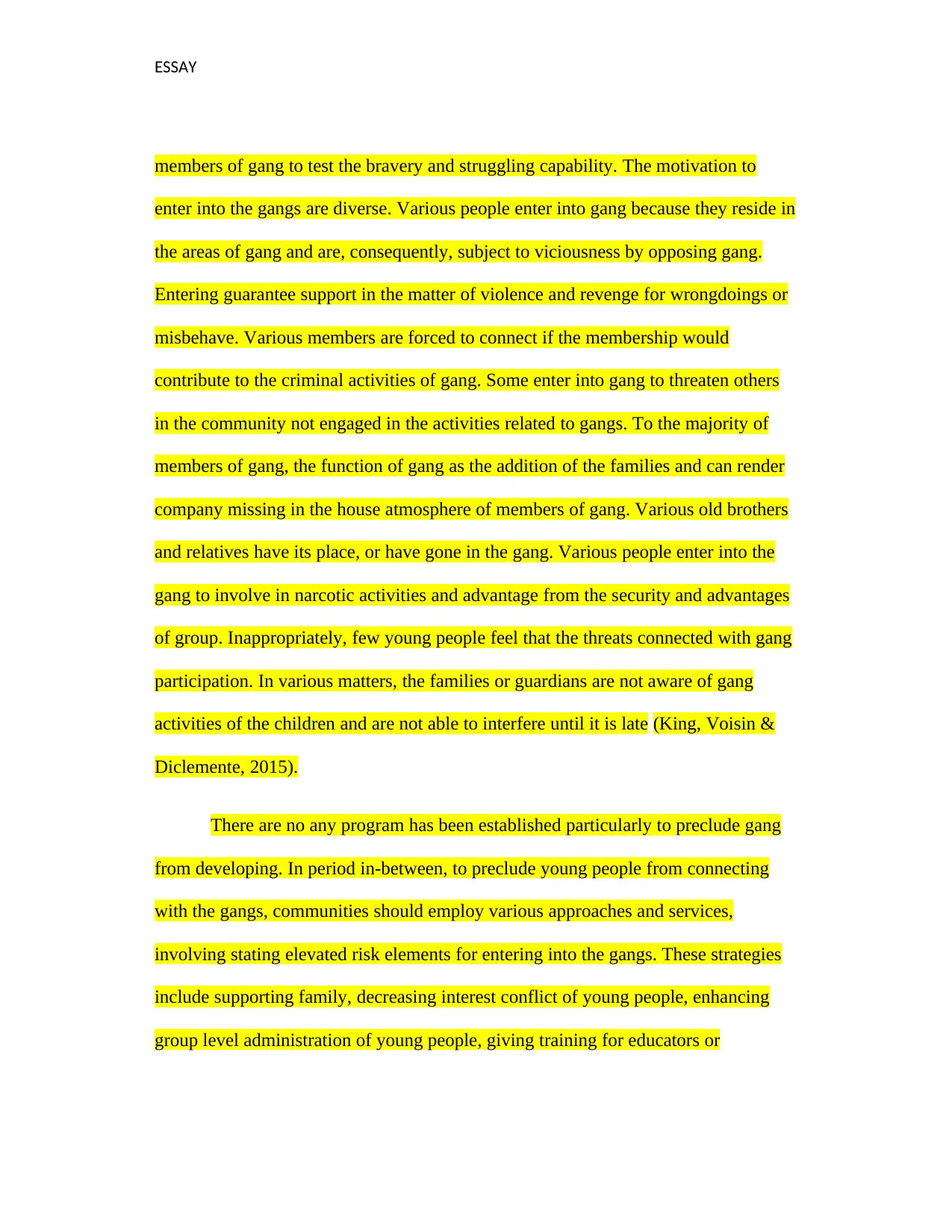
ESSAY
members of gang to test the bravery and struggling capability. The motivation to
enter into the gangs are diverse. Various people enter into gang because they reside in
the areas of gang and are, consequently, subject to viciousness by opposing gang.
Entering guarantee support in the matter of violence and revenge for wrongdoings or
misbehave. Various members are forced to connect if the membership would
contribute to the criminal activities of gang. Some enter into gang to threaten others
in the community not engaged in the activities related to gangs. To the majority of
members of gang, the function of gang as the addition of the families and can render
company missing in the house atmosphere of members of gang. Various old brothers
and relatives have its place, or have gone in the gang. Various people enter into the
gang to involve in narcotic activities and advantage from the security and advantages
of group. Inappropriately, few young people feel that the threats connected with gang
participation. In various matters, the families or guardians are not aware of gang
activities of the children and are not able to interfere until it is late (King, Voisin &
Diclemente, 2015).
There are no any program has been established particularly to preclude gang
from developing. In period in-between, to preclude young people from connecting
with the gangs, communities should employ various approaches and services,
involving stating elevated risk elements for entering into the gangs. These strategies
include supporting family, decreasing interest conflict of young people, enhancing
group level administration of young people, giving training for educators or
members of gang to test the bravery and struggling capability. The motivation to
enter into the gangs are diverse. Various people enter into gang because they reside in
the areas of gang and are, consequently, subject to viciousness by opposing gang.
Entering guarantee support in the matter of violence and revenge for wrongdoings or
misbehave. Various members are forced to connect if the membership would
contribute to the criminal activities of gang. Some enter into gang to threaten others
in the community not engaged in the activities related to gangs. To the majority of
members of gang, the function of gang as the addition of the families and can render
company missing in the house atmosphere of members of gang. Various old brothers
and relatives have its place, or have gone in the gang. Various people enter into the
gang to involve in narcotic activities and advantage from the security and advantages
of group. Inappropriately, few young people feel that the threats connected with gang
participation. In various matters, the families or guardians are not aware of gang
activities of the children and are not able to interfere until it is late (King, Voisin &
Diclemente, 2015).
There are no any program has been established particularly to preclude gang
from developing. In period in-between, to preclude young people from connecting
with the gangs, communities should employ various approaches and services,
involving stating elevated risk elements for entering into the gangs. These strategies
include supporting family, decreasing interest conflict of young people, enhancing
group level administration of young people, giving training for educators or
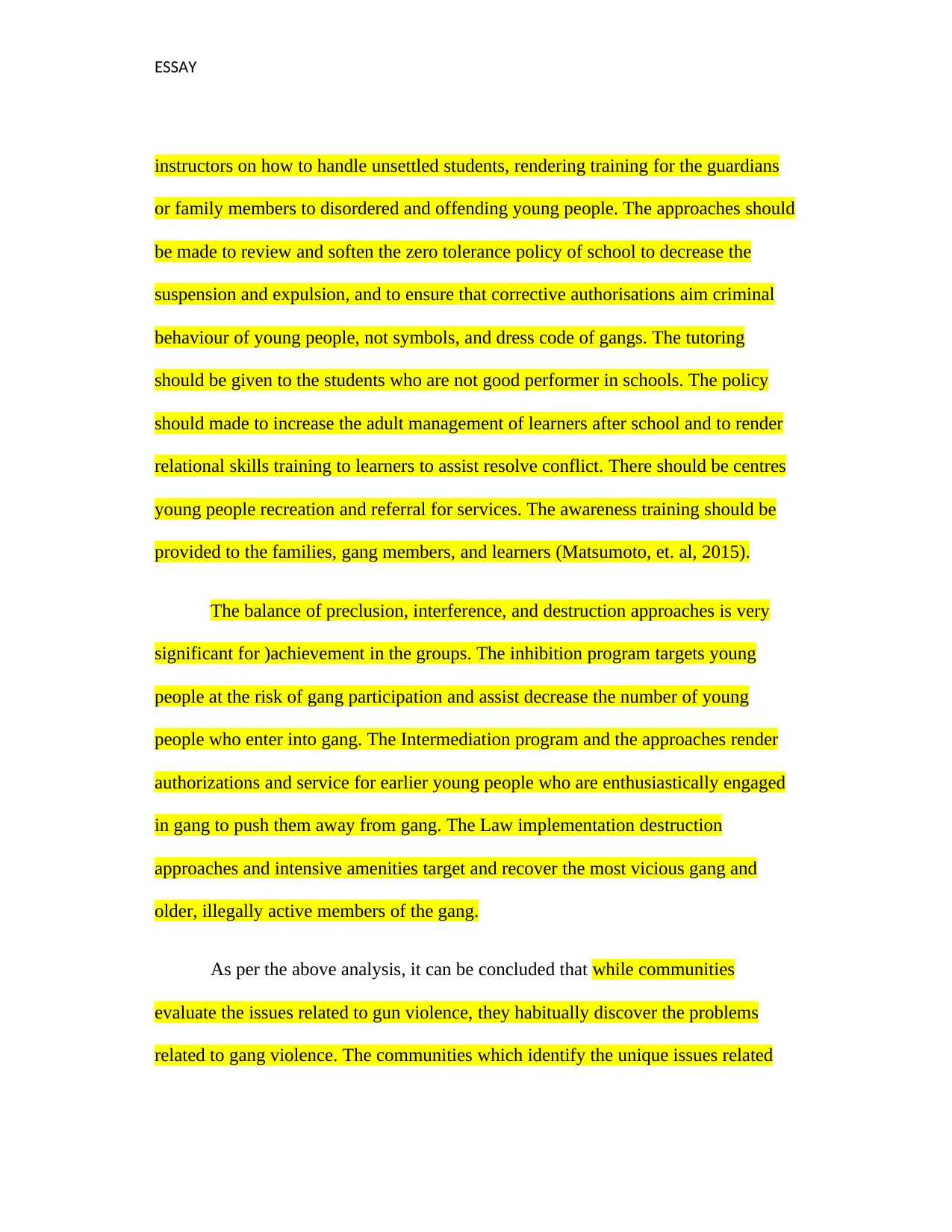
ESSAY
instructors on how to handle unsettled students, rendering training for the guardians
or family members to disordered and offending young people. The approaches should
be made to review and soften the zero tolerance policy of school to decrease the
suspension and expulsion, and to ensure that corrective authorisations aim criminal
behaviour of young people, not symbols, and dress code of gangs. The tutoring
should be given to the students who are not good performer in schools. The policy
should made to increase the adult management of learners after school and to render
relational skills training to learners to assist resolve conflict. There should be centres
young people recreation and referral for services. The awareness training should be
provided to the families, gang members, and learners (Matsumoto, et. al, 2015).
The balance of preclusion, interference, and destruction approaches is very
significant for )achievement in the groups. The inhibition program targets young
people at the risk of gang participation and assist decrease the number of young
people who enter into gang. The Intermediation program and the approaches render
authorizations and service for earlier young people who are enthusiastically engaged
in gang to push them away from gang. The Law implementation destruction
approaches and intensive amenities target and recover the most vicious gang and
older, illegally active members of the gang.
As per the above analysis, it can be concluded that while communities
evaluate the issues related to gun violence, they habitually discover the problems
related to gang violence. The communities which identify the unique issues related
instructors on how to handle unsettled students, rendering training for the guardians
or family members to disordered and offending young people. The approaches should
be made to review and soften the zero tolerance policy of school to decrease the
suspension and expulsion, and to ensure that corrective authorisations aim criminal
behaviour of young people, not symbols, and dress code of gangs. The tutoring
should be given to the students who are not good performer in schools. The policy
should made to increase the adult management of learners after school and to render
relational skills training to learners to assist resolve conflict. There should be centres
young people recreation and referral for services. The awareness training should be
provided to the families, gang members, and learners (Matsumoto, et. al, 2015).
The balance of preclusion, interference, and destruction approaches is very
significant for )achievement in the groups. The inhibition program targets young
people at the risk of gang participation and assist decrease the number of young
people who enter into gang. The Intermediation program and the approaches render
authorizations and service for earlier young people who are enthusiastically engaged
in gang to push them away from gang. The Law implementation destruction
approaches and intensive amenities target and recover the most vicious gang and
older, illegally active members of the gang.
As per the above analysis, it can be concluded that while communities
evaluate the issues related to gun violence, they habitually discover the problems
related to gang violence. The communities which identify the unique issues related
Paraphrase This Document
Need a fresh take? Get an instant paraphrase of this document with our AI Paraphraser
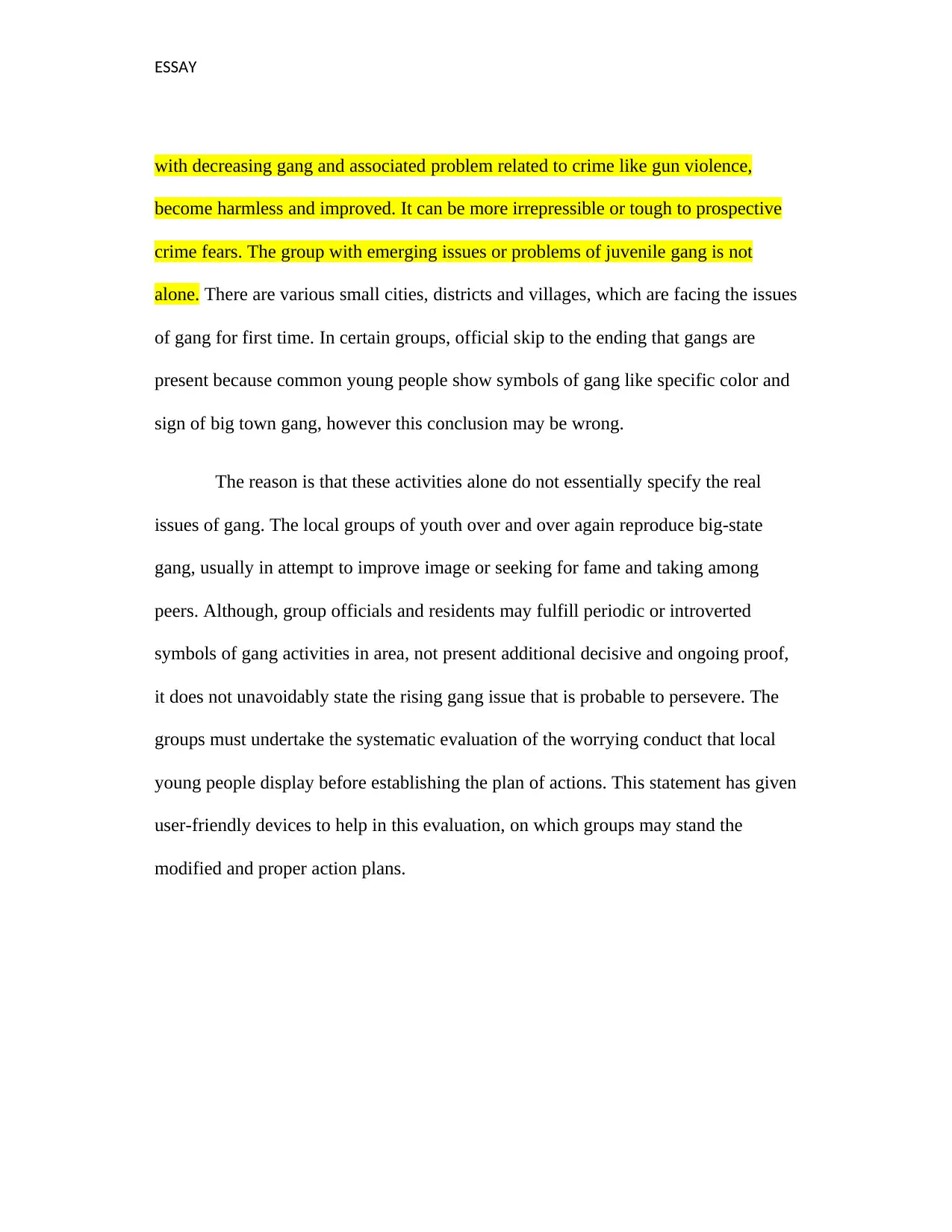
ESSAY
with decreasing gang and associated problem related to crime like gun violence,
become harmless and improved. It can be more irrepressible or tough to prospective
crime fears. The group with emerging issues or problems of juvenile gang is not
alone. There are various small cities, districts and villages, which are facing the issues
of gang for first time. In certain groups, official skip to the ending that gangs are
present because common young people show symbols of gang like specific color and
sign of big town gang, however this conclusion may be wrong.
The reason is that these activities alone do not essentially specify the real
issues of gang. The local groups of youth over and over again reproduce big-state
gang, usually in attempt to improve image or seeking for fame and taking among
peers. Although, group officials and residents may fulfill periodic or introverted
symbols of gang activities in area, not present additional decisive and ongoing proof,
it does not unavoidably state the rising gang issue that is probable to persevere. The
groups must undertake the systematic evaluation of the worrying conduct that local
young people display before establishing the plan of actions. This statement has given
user-friendly devices to help in this evaluation, on which groups may stand the
modified and proper action plans.
with decreasing gang and associated problem related to crime like gun violence,
become harmless and improved. It can be more irrepressible or tough to prospective
crime fears. The group with emerging issues or problems of juvenile gang is not
alone. There are various small cities, districts and villages, which are facing the issues
of gang for first time. In certain groups, official skip to the ending that gangs are
present because common young people show symbols of gang like specific color and
sign of big town gang, however this conclusion may be wrong.
The reason is that these activities alone do not essentially specify the real
issues of gang. The local groups of youth over and over again reproduce big-state
gang, usually in attempt to improve image or seeking for fame and taking among
peers. Although, group officials and residents may fulfill periodic or introverted
symbols of gang activities in area, not present additional decisive and ongoing proof,
it does not unavoidably state the rising gang issue that is probable to persevere. The
groups must undertake the systematic evaluation of the worrying conduct that local
young people display before establishing the plan of actions. This statement has given
user-friendly devices to help in this evaluation, on which groups may stand the
modified and proper action plans.
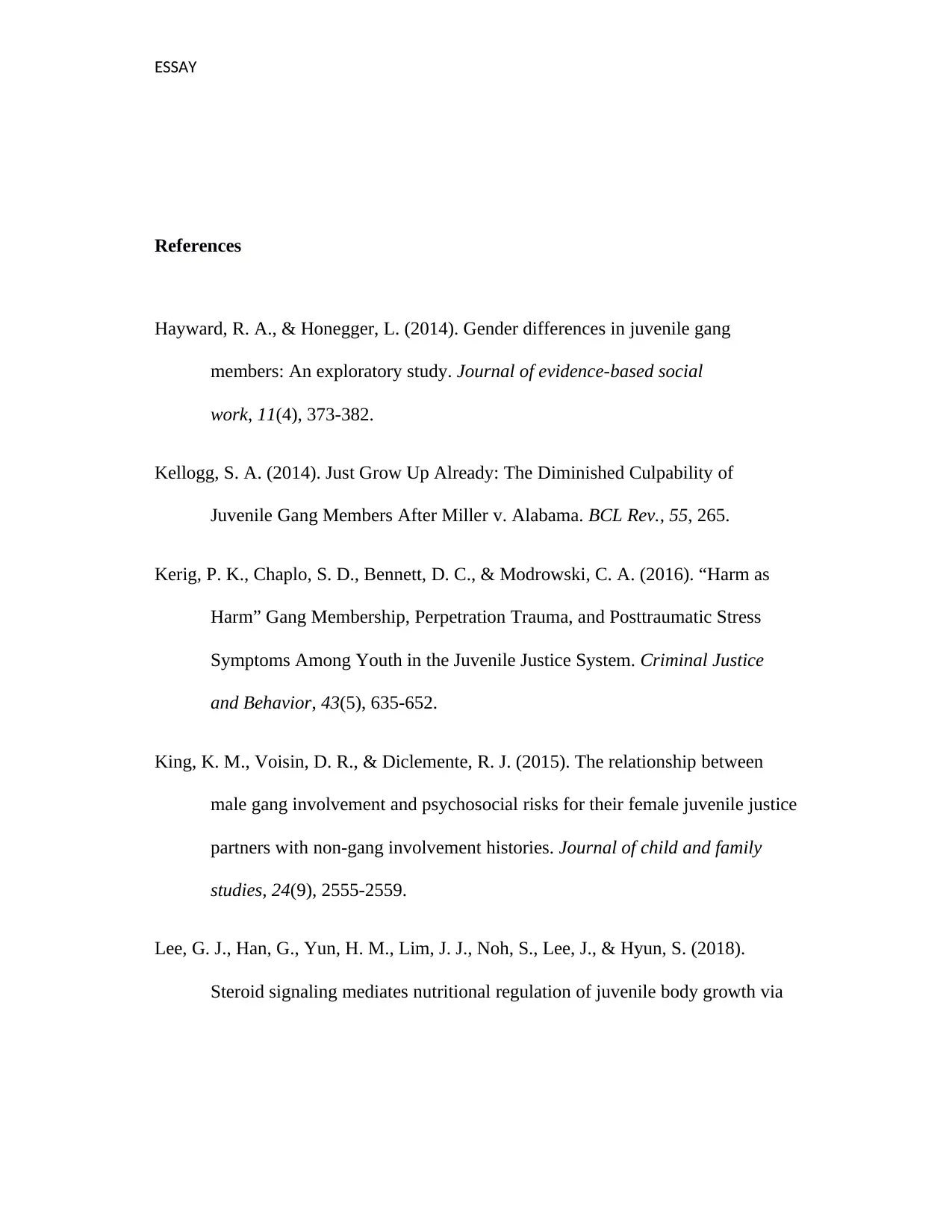
ESSAY
References
Hayward, R. A., & Honegger, L. (2014). Gender differences in juvenile gang
members: An exploratory study. Journal of evidence-based social
work, 11(4), 373-382.
Kellogg, S. A. (2014). Just Grow Up Already: The Diminished Culpability of
Juvenile Gang Members After Miller v. Alabama. BCL Rev., 55, 265.
Kerig, P. K., Chaplo, S. D., Bennett, D. C., & Modrowski, C. A. (2016). “Harm as
Harm” Gang Membership, Perpetration Trauma, and Posttraumatic Stress
Symptoms Among Youth in the Juvenile Justice System. Criminal Justice
and Behavior, 43(5), 635-652.
King, K. M., Voisin, D. R., & Diclemente, R. J. (2015). The relationship between
male gang involvement and psychosocial risks for their female juvenile justice
partners with non-gang involvement histories. Journal of child and family
studies, 24(9), 2555-2559.
Lee, G. J., Han, G., Yun, H. M., Lim, J. J., Noh, S., Lee, J., & Hyun, S. (2018).
Steroid signaling mediates nutritional regulation of juvenile body growth via
References
Hayward, R. A., & Honegger, L. (2014). Gender differences in juvenile gang
members: An exploratory study. Journal of evidence-based social
work, 11(4), 373-382.
Kellogg, S. A. (2014). Just Grow Up Already: The Diminished Culpability of
Juvenile Gang Members After Miller v. Alabama. BCL Rev., 55, 265.
Kerig, P. K., Chaplo, S. D., Bennett, D. C., & Modrowski, C. A. (2016). “Harm as
Harm” Gang Membership, Perpetration Trauma, and Posttraumatic Stress
Symptoms Among Youth in the Juvenile Justice System. Criminal Justice
and Behavior, 43(5), 635-652.
King, K. M., Voisin, D. R., & Diclemente, R. J. (2015). The relationship between
male gang involvement and psychosocial risks for their female juvenile justice
partners with non-gang involvement histories. Journal of child and family
studies, 24(9), 2555-2559.
Lee, G. J., Han, G., Yun, H. M., Lim, J. J., Noh, S., Lee, J., & Hyun, S. (2018).
Steroid signaling mediates nutritional regulation of juvenile body growth via
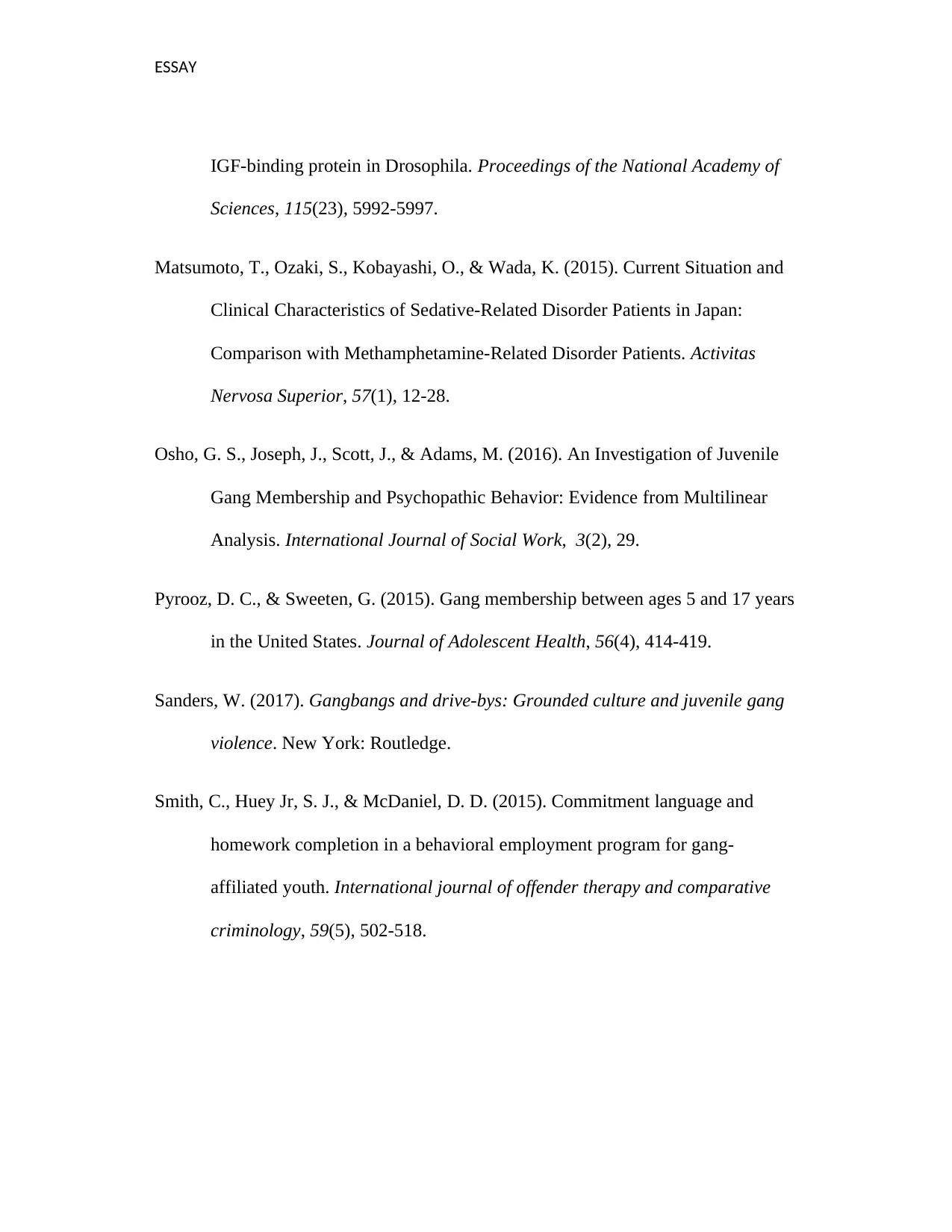
ESSAY
IGF-binding protein in Drosophila. Proceedings of the National Academy of
Sciences, 115(23), 5992-5997.
Matsumoto, T., Ozaki, S., Kobayashi, O., & Wada, K. (2015). Current Situation and
Clinical Characteristics of Sedative-Related Disorder Patients in Japan:
Comparison with Methamphetamine-Related Disorder Patients. Activitas
Nervosa Superior, 57(1), 12-28.
Osho, G. S., Joseph, J., Scott, J., & Adams, M. (2016). An Investigation of Juvenile
Gang Membership and Psychopathic Behavior: Evidence from Multilinear
Analysis. International Journal of Social Work, 3(2), 29.
Pyrooz, D. C., & Sweeten, G. (2015). Gang membership between ages 5 and 17 years
in the United States. Journal of Adolescent Health, 56(4), 414-419.
Sanders, W. (2017). Gangbangs and drive-bys: Grounded culture and juvenile gang
violence. New York: Routledge.
Smith, C., Huey Jr, S. J., & McDaniel, D. D. (2015). Commitment language and
homework completion in a behavioral employment program for gang-
affiliated youth. International journal of offender therapy and comparative
criminology, 59(5), 502-518.
IGF-binding protein in Drosophila. Proceedings of the National Academy of
Sciences, 115(23), 5992-5997.
Matsumoto, T., Ozaki, S., Kobayashi, O., & Wada, K. (2015). Current Situation and
Clinical Characteristics of Sedative-Related Disorder Patients in Japan:
Comparison with Methamphetamine-Related Disorder Patients. Activitas
Nervosa Superior, 57(1), 12-28.
Osho, G. S., Joseph, J., Scott, J., & Adams, M. (2016). An Investigation of Juvenile
Gang Membership and Psychopathic Behavior: Evidence from Multilinear
Analysis. International Journal of Social Work, 3(2), 29.
Pyrooz, D. C., & Sweeten, G. (2015). Gang membership between ages 5 and 17 years
in the United States. Journal of Adolescent Health, 56(4), 414-419.
Sanders, W. (2017). Gangbangs and drive-bys: Grounded culture and juvenile gang
violence. New York: Routledge.
Smith, C., Huey Jr, S. J., & McDaniel, D. D. (2015). Commitment language and
homework completion in a behavioral employment program for gang-
affiliated youth. International journal of offender therapy and comparative
criminology, 59(5), 502-518.
Secure Best Marks with AI Grader
Need help grading? Try our AI Grader for instant feedback on your assignments.
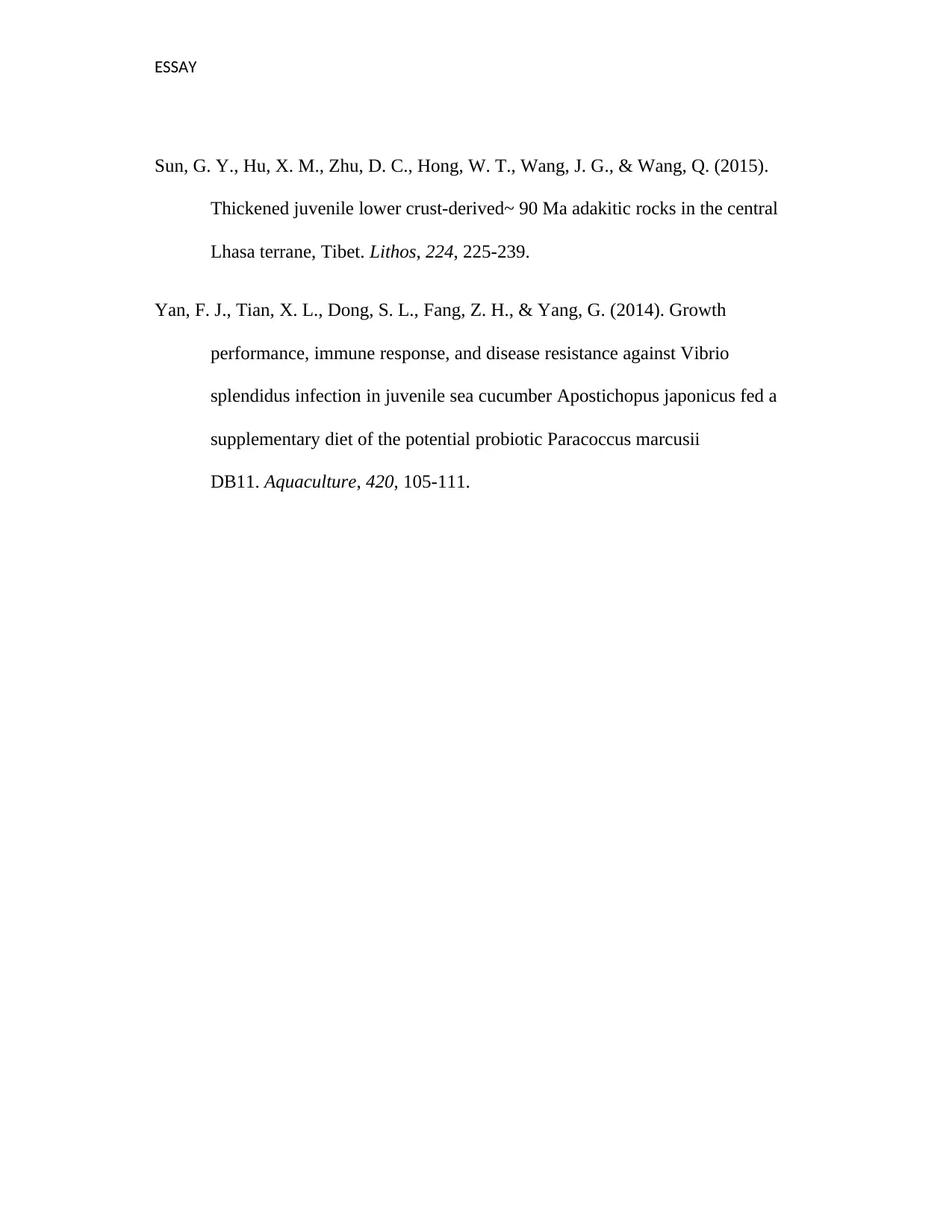
ESSAY
Sun, G. Y., Hu, X. M., Zhu, D. C., Hong, W. T., Wang, J. G., & Wang, Q. (2015).
Thickened juvenile lower crust-derived~ 90 Ma adakitic rocks in the central
Lhasa terrane, Tibet. Lithos, 224, 225-239.
Yan, F. J., Tian, X. L., Dong, S. L., Fang, Z. H., & Yang, G. (2014). Growth
performance, immune response, and disease resistance against Vibrio
splendidus infection in juvenile sea cucumber Apostichopus japonicus fed a
supplementary diet of the potential probiotic Paracoccus marcusii
DB11. Aquaculture, 420, 105-111.
Sun, G. Y., Hu, X. M., Zhu, D. C., Hong, W. T., Wang, J. G., & Wang, Q. (2015).
Thickened juvenile lower crust-derived~ 90 Ma adakitic rocks in the central
Lhasa terrane, Tibet. Lithos, 224, 225-239.
Yan, F. J., Tian, X. L., Dong, S. L., Fang, Z. H., & Yang, G. (2014). Growth
performance, immune response, and disease resistance against Vibrio
splendidus infection in juvenile sea cucumber Apostichopus japonicus fed a
supplementary diet of the potential probiotic Paracoccus marcusii
DB11. Aquaculture, 420, 105-111.
1 out of 11
Related Documents
Your All-in-One AI-Powered Toolkit for Academic Success.
+13062052269
info@desklib.com
Available 24*7 on WhatsApp / Email
![[object Object]](/_next/static/media/star-bottom.7253800d.svg)
Unlock your academic potential
© 2024 | Zucol Services PVT LTD | All rights reserved.





